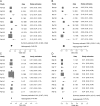ABCD2 score and secondary stroke prevention: meta-analysis and effect per 1,000 patients triaged
- PMID: 26136519
- PMCID: PMC4520819
- DOI: 10.1212/WNL.0000000000001780
ABCD2 score and secondary stroke prevention: meta-analysis and effect per 1,000 patients triaged
Abstract
Objective: Patients with TIA have high risk of recurrent stroke and require rapid assessment and treatment. The ABCD2 clinical risk prediction score is recommended for patient triage by stroke risk, but its ability to stratify by known risk factors and effect on clinic workload are unknown.
Methods: We performed a systematic review and meta-analysis of all studies published between January 2005 and September 2014 that reported proportions of true TIA/minor stroke or mimics, risk factors, and recurrent stroke rates, dichotomized to ABCD2 score </≥4. We calculated the effect per 1,000 patients triaged on stroke prevention services.
Results: Twenty-nine studies, 13,766 TIA patients (range 69-1,679), were relevant: 48% calculated the ABCD2 score retrospectively; few reported on the ABCD2 score's ability to identify TIA mimics or use by nonspecialists. Meta-analysis showed that ABCD2 ≥4 was sensitive (86.7%, 95% confidence interval [CI] 81.4%-90.7%) but not specific (35.4%, 95% CI 33.3%-37.6%) for recurrent stroke within 7 days. Additionally, 20% of patients with ABCD2 <4 had >50% carotid stenosis or atrial fibrillation (AF); 35%-41% of TIA mimics, and 66% of true TIAs, had ABCD2 score ≥4. Among 1,000 patients attending stroke prevention services, including the 45% with mimics, 52% of patients would have an ABCD2 score ≥4.
Conclusion: The ABCD2 score does not reliably discriminate those at low and high risk of early recurrent stroke, identify patients with carotid stenosis or AF needing urgent intervention, or streamline clinic workload. Stroke prevention services need adequate capacity for prompt specialist clinical assessment of all suspected TIA patients for correct patient management.
© 2015 American Academy of Neurology.
Figures

Comment in
-
TIA risk stratification: what an event was and why it happened are more important than a score.Neurology. 2015 Jul 28;85(4):304-5. doi: 10.1212/WNL.0000000000001794. Epub 2015 Jul 1. Neurology. 2015. PMID: 26136522 No abstract available.
-
Stroke: Stroke prevention--time to say goodbye to the ABCD2 score?Nat Rev Neurol. 2015 Oct;11(10):552-3. doi: 10.1038/nrneurol.2015.156. Epub 2015 Sep 1. Nat Rev Neurol. 2015. PMID: 26327364
-
ABCD2 score and secondary stroke prevention: Meta-analysis and effect per 1,000 patients triaged.Neurology. 2016 Feb 16;86(7):697. doi: 10.1212/WNL.0000000000002411. Neurology. 2016. PMID: 26880812 No abstract available.
-
Author Response.Neurology. 2016 Feb 16;86(7):697. Neurology. 2016. PMID: 27303783 No abstract available.
References
-
- Wang Y, Wang Y, Zhao X, et al. Clopidogrel with aspirin in acute minor stroke or transient ischemic attack. N Engl J Med 2013;369:11–19. - PubMed
-
- Johnston SC, Rothwell PM, Nguyen-Huynh MN, et al. Validation and refinement of scores to predict very early stroke risk after transient ischaemic attack. Lancet 2007;369:283–292. - PubMed
-
- Weimar C, Benemann J, Michalski MD, et al. Prediction of recurrent stroke and vascular death in patients with transient ischemic attack or nondisabling stroke: a prospective comparison of validated prognostic scores. Stroke 2010;41:487–493. - PubMed
-
- National Institute for Health and Clinical Excellence (NICE). Stroke: The Diagnosis and Acute Management of Stroke and Transient Ischaemic Attacks. Report No.: CG68. London: National Institute for Health and Clinical Excellence; 2008.
Publication types
MeSH terms
Grants and funding
LinkOut - more resources
Full Text Sources
Medical
